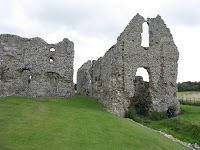To recreate the experience of the monks (as best as I could anyway), I served up Caules Broth (Cabbage Soup). I had to add meat into the soup (apparently meat was allowed when the monks were ill) for the men in this house to have it. The verdict: it was ok, but too bland for our taste. Poor Tortoise was in dismay when he was served monk's soup for dinner that night, exclaiming that he got married so that he would not have to live like a monk! I guess that means we won't have that soup again in this house.
 What else did medieval monks do? Some were given the task of copying manuscripts. This led to us investigating how illumination was done, which has become an entire topic by itself. So far, Tiger has done some preliminary work in this area by trying his hand at making an illuminated alphabet. He has always been eyeing the pen set that I use for pen and ink drawings so this was his chance to get his hands on them.
What else did medieval monks do? Some were given the task of copying manuscripts. This led to us investigating how illumination was done, which has become an entire topic by itself. So far, Tiger has done some preliminary work in this area by trying his hand at making an illuminated alphabet. He has always been eyeing the pen set that I use for pen and ink drawings so this was his chance to get his hands on them.He started off by practising basic medieval lettering. He tried all the different pen nibs before finding the one that worked best for his purpose.
Once Tiger had had enough practise, he copied a sentence (he refused to do more) onto a page in his notebook using his chosen nib and ink. The sentence took three times longer than his normal writing speed to complete, after which he began to illustrate the beginning alphabet. The black outlines were done in ink, while the rest was completed with felt-tip pens and gel pens.
The work shows that Tiger has understood the idea of illuminated alphabets, but I told him that the (imaginary) head monk would expect to see more effort put into the illustration before he would accept it as being fully completed. At this point, I was reminded that "Daddy said we are not monks, and this is not a monastery." That was the end of that conversation.
Being a Mum-with-a-cunning-plan, I'll find ways for us to do some more work on this. Watch this space!
This post is linked up to several blog hops, where you can visit to see what other homeschoolers have been busy with.














I love this post! Wonderful to see the ruins and the pictures of what it had once looked like. Wonderful! I laughed at the soup story. The calligraphy pens are a great idea. Thank you so much for sharing this with us.
ReplyDeleteThis post makes me smile. I am the only one in my house who enjoys eating cabbage, no matter how it is cooked. I like seeing how you bring so much interest into your lessons. Thanks for linking again.
ReplyDeleteI love visiting old ruins. "We are not monks...." ha ha ha ha ha, awesome!
ReplyDeleteGreat study -- and those ruins are just beautiful!
ReplyDeleteWhat an awesome opportunity to be able to see the ruins.
ReplyDeleteBlessings,
Dawn
LOVE the history! My son SO enjoyed seeing all the historical things (especially Stonehedge) during his England visit last year.
ReplyDelete